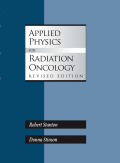
Applied Physics for Radiation Oncology, Revised Edition
Author: Robert Stanton and Donna StinsonISBN: 9781930524408
Published: 2009 | 292 pp. | Softcover
Price: $ 105.00
Medical Physics, 37 (6) | June 2010
Description
This is a book on radiological physics that covers basic principles of radiation physics and how they apply to radiation therapy. It is a well-referenced and easy to read text. This is the revised edition of an earlier text that has been expanded to cover new treatment planning techniques without jeopardizing the basic physics coverage.
Purpose
The author has successfully addressed the most common aspects of radiation physics from a practical perspective. It has a nice flow of information that can be very useful to radiation therapy technology students and dosimetrists. Further investigation by an individual can be achieved via the reference list provided at the end of each chapter.
Audience
This book is primarily directed to cover the needs of radiation therapy technology students and it has successfully done so, in my opinion. However, it can also be a great supplemental resource for medical dosimetrists and radiation oncology residents who need to practice problem solving. I would strongly recommend the text to any radiation therapy technology training program.
Contents/Features
The contents of the book are laid out in 17 chapters and seven appendixes. All chapters include black and white graphs and figures to assist the reader. There are numerous tables with data and information pertinent to the text that can be used in problem solving. At the end of each chapter, the authors have presented problems and a bibliography. Appendix 4 provides the answers to the problems in the text. It is worth mentioning that there is a short list of objectives at the beginning of every chapter that allows the reader to quickly assess its contents.
Chapter 1 covers basic physical quantities such as matter, force, and energy. Chapters 2 and 3 cover properties and kinds of radiation and radiation production. Between chapters 4 and 6, the authors cover radiation quality, the interactions of radiation with matter, and the principles and methods of radiation measurements.
Chapters 7 through 12 cover the definitions of all the radiation quantities, such as exposure, dose, kerma, dose equivalent, etc. Then, clinical properties of photon beams, clinical accelerators and other radiation producing devices, and extensive photon beam dosimetry are addressed.
Since electron beams have been routinely used in radiotherapy and are an integral part of standard treatment modalities, they are covered in Chapter 13, along with their dosimetry.
Chapters 14 and 15 extend all the previous knowledge into the treatment planning methods and applications. 3D treatment planning, intensity modulated radiotherapy, and image guided radiotherapy are covered in short but well-written paragraphs.
The text closes with Chapter 16 on brachytherapy physics and brachytherapy procedures and Chapter 17 on radiation safety and radiation protection. The appendixes at the end of the text contain an adequate number of data tables that can be used for problem solving and practice.
Assessment/Comparison
The text has a practical approach to the application of radiotherapy physics and planning that will assist, primarily, radiation therapy technologists in building their background knowledge and understanding why and how things happen in the clinical environment. The text has a didactic layout that makes it a good candidate for a course in radiotherapy physics and its application. For medical residents in radiation oncology, it can serve as a quick review “manual” that incorporates all the basic definitions and some recent developments in the field. Without hesitation, I recommend the text as a teaching tool for radiation therapy technology training programs.
Dimitris Mihailidis, Ph.D.
Charleston Radiation Therapy Consultants
Charleston, WV


